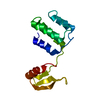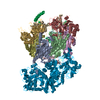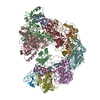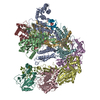+ Open data
Open data
- Basic information
Basic information
| Entry | Database: PDB / ID: 7ecw | ||||||
|---|---|---|---|---|---|---|---|
| Title | The Csy-AcrIF14-dsDNA complex | ||||||
 Components Components |
| ||||||
 Keywords Keywords |  IMMUNE SYSTEM/RNA/DNA / IMMUNE SYSTEM/RNA/DNA /  inhibitor / inhibitor /  complex / complex /  IMMUNE SYSTEM / IMMUNE SYSTEM /  IMMUNE SYSTEM-RNA-DNA complex IMMUNE SYSTEM-RNA-DNA complex | ||||||
| Function / homology |  Function and homology information Function and homology informationCRISPR-associated protein Csy1 / CRISPR-associated protein (Cas_Csy1) / CRISPR-associated protein Csy2 / CRISPR-associated protein (Cas_Csy2) / CRISPR-associated protein Csy3 / CRISPR-associated protein (Cas_Csy3) Similarity search - Domain/homology | ||||||
| Biological species |   Pseudomonas aeruginosa (bacteria) Pseudomonas aeruginosa (bacteria) Moraxella phage Mcat5 (virus) Moraxella phage Mcat5 (virus) | ||||||
| Method |  ELECTRON MICROSCOPY / ELECTRON MICROSCOPY /  single particle reconstruction / single particle reconstruction /  cryo EM / Resolution: 3.1 Å cryo EM / Resolution: 3.1 Å | ||||||
 Authors Authors | Zhang, L.X. / Feng, Y. | ||||||
| Funding support |  China, 1items China, 1items
| ||||||
 Citation Citation |  Journal: Nucleic Acids Res / Year: 2021 Journal: Nucleic Acids Res / Year: 2021Title: Insights into the dual functions of AcrIF14 during the inhibition of type I-F CRISPR-Cas surveillance complex. Authors: Xi Liu / Laixing Zhang / Yu Xiu / Teng Gao / Ling Huang / Yongchao Xie / Lingguang Yang / Wenhe Wang / Peiyi Wang / Yi Zhang / Maojun Yang / Yue Feng /  Abstract: CRISPR-Cas systems are bacterial adaptive immune systems, and phages counteract these systems using many approaches such as producing anti-CRISPR (Acr) proteins. Here, we report the structures of ...CRISPR-Cas systems are bacterial adaptive immune systems, and phages counteract these systems using many approaches such as producing anti-CRISPR (Acr) proteins. Here, we report the structures of both AcrIF14 and its complex with the crRNA-guided surveillance (Csy) complex. Our study demonstrates that apart from interacting with the Csy complex to block the hybridization of target DNA to the crRNA, AcrIF14 also endows the Csy complex with the ability to interact with non-sequence-specific dsDNA as AcrIF9 does. Further structural studies of the Csy-AcrIF14-dsDNA complex and biochemical studies uncover that the PAM recognition loop of the Cas8f subunit of the Csy complex and electropositive patches within the N-terminal domain of AcrIF14 are essential for the non-sequence-specific dsDNA binding to the Csy-AcrIF14 complex, which is different from the mechanism of AcrIF9. Our findings highlight the prevalence of Acr-induced non-specific DNA binding and shed light on future studies into the mechanisms of such Acr proteins. | ||||||
| History |
|
- Structure visualization
Structure visualization
| Movie |
 Movie viewer Movie viewer |
|---|---|
| Structure viewer | Molecule:  Molmil Molmil Jmol/JSmol Jmol/JSmol |
- Downloads & links
Downloads & links
- Download
Download
| PDBx/mmCIF format |  7ecw.cif.gz 7ecw.cif.gz | 519.6 KB | Display |  PDBx/mmCIF format PDBx/mmCIF format |
|---|---|---|---|---|
| PDB format |  pdb7ecw.ent.gz pdb7ecw.ent.gz | 416 KB | Display |  PDB format PDB format |
| PDBx/mmJSON format |  7ecw.json.gz 7ecw.json.gz | Tree view |  PDBx/mmJSON format PDBx/mmJSON format | |
| Others |  Other downloads Other downloads |
-Validation report
| Arichive directory |  https://data.pdbj.org/pub/pdb/validation_reports/ec/7ecw https://data.pdbj.org/pub/pdb/validation_reports/ec/7ecw ftp://data.pdbj.org/pub/pdb/validation_reports/ec/7ecw ftp://data.pdbj.org/pub/pdb/validation_reports/ec/7ecw | HTTPS FTP |
|---|
-Related structure data
| Related structure data |  31059MC  7du0C  7ecvC M: map data used to model this data C: citing same article ( |
|---|---|
| Similar structure data |
- Links
Links
- Assembly
Assembly
| Deposited unit | 
|
|---|---|
| 1 |
|
- Components
Components
-Protein , 4 types, 10 molecules ABCDEFGHIJ
| #1: Protein | Mass: 49313.254 Da / Num. of mol.: 1 Source method: isolated from a genetically manipulated source Source: (gene. exp.)   Pseudomonas aeruginosa (bacteria) / Gene: csy1, ALP65_00954, IPC1505_30690 / Production host: Pseudomonas aeruginosa (bacteria) / Gene: csy1, ALP65_00954, IPC1505_30690 / Production host:   Escherichia coli (E. coli) / References: UniProt: A0A3A8DDU9 Escherichia coli (E. coli) / References: UniProt: A0A3A8DDU9 | ||
|---|---|---|---|
| #2: Protein | Mass: 36244.074 Da / Num. of mol.: 1 Source method: isolated from a genetically manipulated source Source: (gene. exp.)   Pseudomonas aeruginosa (bacteria) Pseudomonas aeruginosa (bacteria)Gene: csy2, ALP65_00953, EQH76_13810, NCTC13437_01526, PACL_0128 Production host:   Escherichia coli (E. coli) / References: UniProt: B3G161 Escherichia coli (E. coli) / References: UniProt: B3G161 | ||
| #3: Protein | Mass: 37623.324 Da / Num. of mol.: 6 Source method: isolated from a genetically manipulated source Source: (gene. exp.)   Pseudomonas aeruginosa (bacteria) / Gene: IPC1505_30680, IPC36_28835 / Production host: Pseudomonas aeruginosa (bacteria) / Gene: IPC1505_30680, IPC36_28835 / Production host:   Escherichia coli (E. coli) / References: UniProt: A0A659BSG0 Escherichia coli (E. coli) / References: UniProt: A0A659BSG0#4: Protein | Mass: 14297.373 Da / Num. of mol.: 2 Source method: isolated from a genetically manipulated source Source: (gene. exp.)  Moraxella phage Mcat5 (virus) / Production host: Moraxella phage Mcat5 (virus) / Production host:   Escherichia coli (E. coli) / References: UniProt: A0A0R6PCL0 Escherichia coli (E. coli) / References: UniProt: A0A0R6PCL0 |
-RNA chain , 1 types, 1 molecules M
| #5: RNA chain | Mass: 19265.404 Da / Num. of mol.: 1 Source method: isolated from a genetically manipulated source Source: (gene. exp.)   Pseudomonas aeruginosa (bacteria) / Production host: Pseudomonas aeruginosa (bacteria) / Production host:   Escherichia coli (E. coli) / References: GenBank: 313291946 Escherichia coli (E. coli) / References: GenBank: 313291946 |
|---|
-DNA chain , 2 types, 2 molecules NO
| #6: DNA chain | Mass: 16708.691 Da / Num. of mol.: 1 Source method: isolated from a genetically manipulated source Source: (gene. exp.)   Pseudomonas aeruginosa (bacteria) / Production host: Pseudomonas aeruginosa (bacteria) / Production host:   Escherichia coli (E. coli) Escherichia coli (E. coli) |
|---|---|
| #7: DNA chain | Mass: 16574.561 Da / Num. of mol.: 1 Source method: isolated from a genetically manipulated source Source: (gene. exp.)   Pseudomonas aeruginosa (bacteria) / Production host: Pseudomonas aeruginosa (bacteria) / Production host:   Escherichia coli (E. coli) Escherichia coli (E. coli) |
-Experimental details
-Experiment
| Experiment | Method:  ELECTRON MICROSCOPY ELECTRON MICROSCOPY |
|---|---|
| EM experiment | Aggregation state: PARTICLE / 3D reconstruction method:  single particle reconstruction single particle reconstruction |
- Sample preparation
Sample preparation
| Component |
| ||||||||||||||||||||||||
|---|---|---|---|---|---|---|---|---|---|---|---|---|---|---|---|---|---|---|---|---|---|---|---|---|---|
| Source (natural) |
| ||||||||||||||||||||||||
| Source (recombinant) |
| ||||||||||||||||||||||||
| Buffer solution | pH: 7 | ||||||||||||||||||||||||
| Specimen | Embedding applied: NO / Shadowing applied: NO / Staining applied : NO / Vitrification applied : NO / Vitrification applied : YES : YES | ||||||||||||||||||||||||
Vitrification | Cryogen name: ETHANE |
- Electron microscopy imaging
Electron microscopy imaging
| Microscopy | Model: FEI TITAN |
|---|---|
| Electron gun | Electron source : :  FIELD EMISSION GUN / Accelerating voltage: 300 kV / Illumination mode: OTHER FIELD EMISSION GUN / Accelerating voltage: 300 kV / Illumination mode: OTHER |
| Electron lens | Mode: DARK FIELD |
| Image recording | Electron dose: 50 e/Å2 / Film or detector model: GATAN K3 (6k x 4k) |
- Processing
Processing
| Software | Name: PHENIX / Version: 1.17.1_3660: / Classification: refinement | ||||||||||||||||||||||||
|---|---|---|---|---|---|---|---|---|---|---|---|---|---|---|---|---|---|---|---|---|---|---|---|---|---|
CTF correction | Type: NONE | ||||||||||||||||||||||||
3D reconstruction | Resolution: 3.1 Å / Resolution method: FSC 0.143 CUT-OFF / Num. of particles: 127454 / Symmetry type: POINT | ||||||||||||||||||||||||
| Refine LS restraints |
|
 Movie
Movie Controller
Controller











 PDBj
PDBj































































